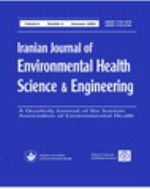
|
Iranian Journal of Environmental Health, Science and Engineering
Iranian Association of Environmental Health (IAEH)
ISSN: 1735-1979
Vol. 7, No. 3, 2010, pp. 287-298
|
 Bioline Code: se10033
Bioline Code: se10033
Full paper language: English
Document type: Research Article
Document available free of charge
|
|
|
Iranian Journal of Environmental Health, Science and Engineering, Vol. 7, No. 3, 2010, pp. 287-298
| en |
Metallothionein Induction In Two Species Of Pseudomonas Exposed To Cadmium And Copper Contamination
Enshaei, M.; Khanafari, A. & Sepahey, A. Akhavan
Abstract
The main objective of this study was to investigate the effect of cadmium (II) and copper (II) salts concentrations on uptake, tolerance, growth pattern and metallothionein induction as a biomarker by two bacterial strains including Pseudomonas aeruginosa and Pseudomonas putida PTCC 1694. For this purpose, the minimum inhibition concentration, minimum bactericidal concentration, growth and uptake patterns of Pseudomonas aeruginosa and Pseudomonas putida were determined in culture media with 0.09-10mM/L of Cd and Cu salts in pH7±0.2= at 30±2 ºC. Growth rate and amount of metal uptake were determined by spectrophotometer and atomic absorption assay every 24 hours for 14 to 23 days. Biosorption of the heavy metals on the bacterial cell-wall surfaces after preparation were analyzed by Scanning Electron Microscopy (SEM) equipped with Energy Dispersive Spectroscopy (EDS). Metallothionein production was evaluated by silver saturation methods. The results showed that the growth was directly inhibited at the concentration of 1.5 mM/L Cd(II) and 9 mM/L Cu(II) for P. aeruginosa and 0.95 mM/L Cd(II) and 7.5 mM/L Cu(II) for P. putida. Results of the growth pattern showed that the log phase for Pseudomonas aeruginosa and Pseudomonas putida lasted 48 and 121 hours, 217 and 121 in presence of cadmium and copper, respectively. The stationary phase was very short and very soon after log phase, the microorganisms went into death phase. The maximum biosorption of metal from cultures of two strains was 36.6% and 28% of cadmium and 80% and 47% of copper of final concentration. The result of elemental analysis with SEM-EDS approved surface adsorption of cadmium and copper. Since the exact number of Ag-binding sites per metallothionein molecules is unknown for Pseudomonas putida, results were expressed as nanomoles of Ag-binding site per gram of wet weight as equal to 0.0033 and 0.0031.
Keywords
Pseudomonas aeruginosa ; Pseudomonas putida ; Metallothionein; Ag-binding site; Cadmium; Copper
|
| |
© Copyright 2010 Iran Journal of EnvironHealth Sci Eng.
Alternative site location: http://diglib.tums.ac.ir/pub/
|
|
